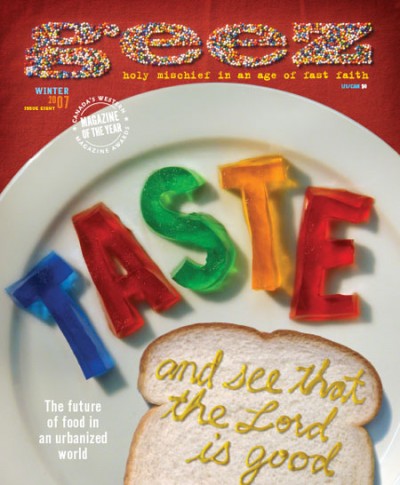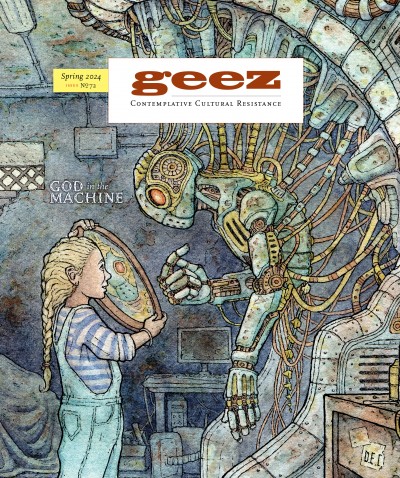Countrify the city, modernize the rural: An interview with J.B. MacKinnon
Distance is the enemy of awareness. – J.B. MacKinnon
For one year, Alisa Smith and her partner J.B. MacKinnon ate only food that came from within 100 miles of their urban Vancouver home. Their bestselling book, The 100-Mile Diet: A Year of Local Eating is helping to fuel the growing popularity of local, trustworthy food. In an interview with Geez, J.B. reflects on the urban-rural divide in society, a divide they had to continually cross in their search for food.
What have you observed about the interplay between urban and rural culture?
There still is a huge divide between city and country. I actually think there are two divides – between city and country, and between human and non-human. Even in rural areas we see a huge breach between the way we live and the natural landscapes that surround us.
I think what we’re seeing is a very low level of integration between ourselves and the ecologies we live in and that’s really what drives the lack of environmental sustainability in society both at a rural and an urban level. But the gap between the city and the country may be the most profound. This is where it gets most interesting because a lot of the people who are most committed to sustainability are also strong advocates of the idea that the drift from country to city is a good one as long as we manage it well. They believe we can pack more people into cities, and those cities can be more environmentally sustainable than anything that we’ve seen in the past, and that that might be the most sustainable way for humans to live. Well, I just don’t buy that argument.
We can’t achieve ecological sustainability with the kind of deep disconnection that urban living breeds between us and the planet. And that’s been the deepest value of the 100-mile diet – there is this thing we do three times a day, if we’re lucky, we eat food and that can be a constant reminder that this planet still does sustain us. That is an obvious statement but it’s something we seem to forget. That’s been the really deep value – the constant reminder that we live in an ecology and that ecology sustains us even at a simple level of just nourishing our bodies.
Earlier you said urbanization isn’t really the answer – what is?
In a way urbanization is the answer, I just don’t think the megacity is the answer. I think humans are social beings, we will always live grouped together. But I think what we need to do is countrify the city and modernize the rural, so that we have kind of an even spread – more people out in rural areas but rural areas that are fueled with some of what we have in the city to make them places where a lot of creativity can happen. Alisa often points out that some of the periods in history that we look at as some of the most exciting in terms of the arts, or the development of philosophy, happened in concentrated centers of no more than a few thousand people. That’s not happening in the rural landscapes of North America.
We definitely can’t romanticize rural life at this point, because it doesn’t look that great either. A lot of the small cities and towns that we see as we travel are pretty devoid of life; they don’t have a lot going on. There’s not a good mix of age groups or cultural groups. Many of the things that make big cities most exciting just aren’t happening in the country. In a lot of ways, we’ve turned the country into something we’ve parisitized to feed the cities in all kinds of different ways – not only food, but all the other resources, material resources that we need to fuel the cities.
As a society we need to say that living outside of megacities is a valuable thing to do, and make the choices necessary to make those places more livable, more exciting, places that you’re going to want to go if you are 20 years old and looking around for a place to make your contribution. We need to see an urban-rural drift, but we need to see it done in a way that doesn’t just replicate the sprawl and the disconnection that we see in the big urban centres.



Sorry, comments are closed.